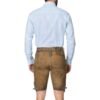German Traditional Wear: An In-Depth Look at Lederhosen
Lederhosen, which translates to “leather breeches,” are a quintessential part of German traditional wear, particularly in the Bavarian region. These distinctive garments have a rich history and cultural significance that extends beyond their practical origins. This guide explores the origins, evolution, styles, and cultural relevance of lederhosen in German tradition.
Origins of Lederhosen
Lederhosen originated in the Alpine regions of Germany, Austria, and Switzerland during the late Middle Ages. Initially designed as durable workwear for peasants and laborers, these leather shorts were crafted to withstand harsh weather conditions and rugged outdoor activities. The practicality of lederhosen made them popular among farmers, hunters, and laborers who required comfortable yet sturdy clothing for their daily tasks.
By the 18th century, lederhosen began to gain popularity among the upper classes as well. Nobility adopted this rural attire for outdoor activities like horseback riding and hunting, leading to a blend of styles that incorporated elements of both peasant and aristocratic fashion. This shift marked the beginning of lederhosen’s transformation from functional workwear to a symbol of Bavarian identity.
Evolution Through the Ages
As time progressed, lederhosen evolved into a staple of German traditional wear. By the 19th century, they became closely associated with festive occasions and cultural celebrations, particularly Oktoberfest. This famous festival celebrates Bavarian culture with music, food, and traditional attire, making lederhosen a common sight during these events.
The design of lederhosen has also evolved over time. While they were originally knee-length or longer for practical use, modern styles often feature shorter cuts that end just above the knee. These variations are often embellished with intricate embroidery and decorative motifs that reflect regional differences in style.
Styles of Lederhosen
Lederhosen come in various styles and materials, each reflecting different aspects of Bavarian culture:
- Traditional Lederhosen: Typically made from high-quality leather, these shorts are characterized by their craftsmanship and durability. They often feature decorative stitching and motifs that signify regional heritage.
- Bundhosen: A longer version of lederhosen that extends past the knee. Bundhosen are less common but are worn for specific occasions or colder weather.
- Trachten Lederhosen: This term refers to lederhosen designed specifically for traditional costumes worn during festivals and celebrations. They are often paired with a dirndl for women, creating a complementary look.
Cultural Significance
Lederhosen hold a special place in German traditional wear culture as symbols of national pride and heritage. They represent a connection to Bavarian traditions and rural life. During Oktoberfest and other cultural festivals, wearing lederhosen is a way to celebrate German identity and community spirit.
The resurgence of interest in traditional clothing has led to a renewed appreciation for lederhosen in contemporary fashion. Many people now wear them not only during festivals but also as everyday attire, showcasing their versatility and timeless appeal.
Conclusion
Lederhosen are more than just traditional garments; they embody the spirit of Bavarian culture and history. From their humble beginnings as workwear to their status as iconic symbols of German identity, these leather shorts have undergone significant transformations while maintaining their cultural relevance. Whether worn during festive occasions or as part of everyday attire, lederhosen continue to celebrate the rich heritage of Germany and its people. In summary, understanding lederhosen involves appreciating their historical context, evolution in style, and ongoing significance in modern German culture. As they remain an essential part of traditional wear, lederhosen will undoubtedly continue to be cherished by future generations.











Reviews
There are no reviews yet.